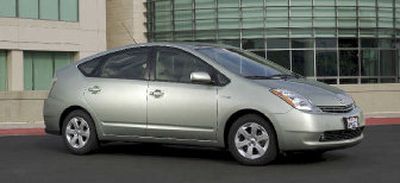Prius does good while doing well

Newsflash for the naysayers: Toyota’s Prius survived to see a second generation and is a better car for it.
When Honda’s Insight and Toyota’s Prius debuted in the U.S. back at the turn of the century, the doubters were legion.
The batteries wouldn’t last, they wailed, and would be expensive to replace. They’d be dangerous and would put first responders at risk in the event of an accident. Besides, Americans would never pay the $3,000 premium exacted by the new technology.
But here we are, six years down the road and more hybrids than ever are scuttling around the country and every year they get better.
Although the number and variety of hybrids have grown — they now range from Honda’s two-passenger Insight to the Lexus RX 400h SUV — the Prius has become the genre’s poster child.
Hollywood is especially smitten. Larry David pilots his Prius from one personal calamity to the next in his HBO show “Curb Your Enthusiasm” and Leonardo di Caprio, Jennifer Anniston and George Clooney all have arrived at the Oscars in theirs. Locally, the City of Spokane and Gonzaga University have added the Prius to their fleets, a true sign of mainstream acceptance.
So, what’s our poster child been up to since we reviewed it last?
In 2004, the Prius underwent a stem-to-stern makeover that left it larger and roomier, more powerful, more fuel-efficient and even more environmentally beneficent — all without a price increase. Base price remains $21,725.
The ‘04 Prius got Toyota’s third-generation hybrid system, called Hybrid Synergy Drive, which bumped net horsepower from 98 to 110 and peak torque from 258 to 295 foot/pounds. Fuel efficiency increased to an EPA-rated 60 city/51 highway and emissions dropped 30 percent or 90 percent less than a conventional gasoline-powered vehicle.
The Prius earns California’s Super Low Emissions Vehicle (SULEV) rating and qualifies as an Advanced Technology Partial Zero Emissions Vehicle (AT-PZEV). That standard requires that it 1) allow no evaporation of unburned fuels; 2) pass a 150,000-mile durability test; and 3) offer an extended emissions-system warranty.
Hybrid Synergy Drive comprises a small (1.5-liter) four-cylinder gasoline engine and an electric drive motor. When the Prius is coasting or braking, energy that normally would be lost as heat is captured and routed either to the drivetrain or to a battery pack hidden under the rear seats.
Since the batteries are constantly being recharged, the Prius never needs to be plugged in.
The Prius is more than a technological marvel, though; it’s also a real-world car, designed for even those who fail the hair-shirt test.
Originally a four-door sedan, the Prius became a four-door hatchback that offers cabin space rivaling the Camry’s and a large, flexible cargo compartment. Nominally a five-passenger midsize sedan, it accommodates four adults comfortably.
The standard-features list includes automatic climate control, which is powered by the electrical system to enhance fuel efficiency and allow operation when the gasoline engine is shut down.
Other standard features include steering-wheel-mounted redundant audio controls, rear intermittent wiper, cabin air filtration, cruise control, traction control, heated side mirrors, power windows, mirrors and door locks and remote keyless entry.
The standard anti-lock braking system includes brake-force distribution and brake assist, while vehicle stability control and side-impact and curtain-style bags are optional.
Everyone who sees the Prius asks the same question — how does it drive?
Operation of the Hybrid Synergy Drive is essentially seamless. Under ideal conditions, the Prius can do about 20 mph on battery power alone but normally starts on battery power, adding the gasoline engine when the driver pushes the throttle. If the battery pack is well-charged, the engine shuts down when the Prius comes to a full stop.
If you’re attentive, you will feel a slight shudder as the engine kicks in.
As in the first generation Prius, the steering is quick but has an artificial feel. A slight tugging sensation can be felt during deceleration and braking, a side effect of the effort required to convert energy loss to usable power.
Acceleration is modest — 0-60 comes up in just over 10 seconds — but passing power is improved over the first generation.
The unconventional interior design places the digital speedometer under a large, recessed binnacle ahead of the driver and the balance of the controls and gauges in a central pod that houses a display monitor, which doubles as a screen for the optional navigation system.
Fit-and-finish and materials quality are typical Toyota and this year the seats can be optionally outfitted in leather, an ironic touch given the overtones of self-denial we all expected would accompany energy-sensitivity.
Our tester even came with the too-cool Smart Key option, which allows the driver to unlock the doors and start the engine without de-pocketing the keys.
By now, drivers know they won’t experience the lofty numbers predicted by the EPA, but can expect in combined city and highway driving to average about 45 mpg. Factor in those astonishing emissions numbers and it’s not hard to see how one can do good while doing well.